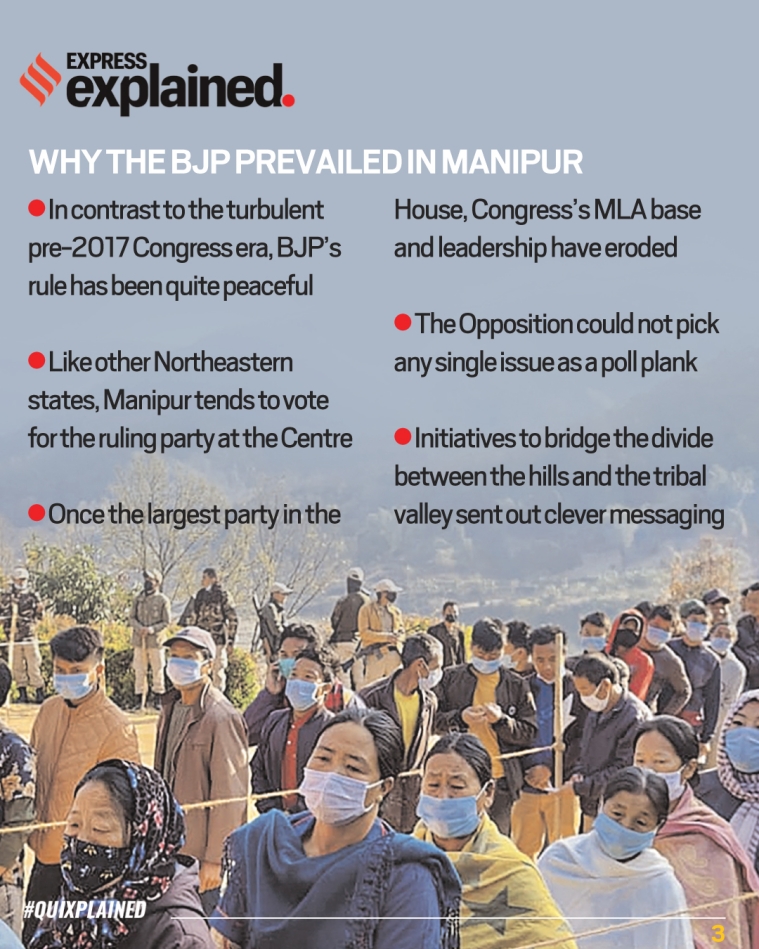Manipur Assembly Election Results 2022 Explained: Why the BJP prevailed in Manipur
Like other small states of the Northeast region, Manipur tends to vote for the party which is in power at the Centre. With BJP being at the helm, the party becomes an easier and safer choice for voters in Manipur.
 Chief Minister N Biren Singh and Manipur BJP chief A Sharda Devi dance in celebrations after the party's victory in Assembly polls, in Imphal, Thursday, March 10, 2022. (PTI Photo)
Chief Minister N Biren Singh and Manipur BJP chief A Sharda Devi dance in celebrations after the party's victory in Assembly polls, in Imphal, Thursday, March 10, 2022. (PTI Photo) Peace, stability and normalcy plank: In contrast to the tumultuous Congress regime under the Okram Ibobi Singh, marked by bandhs, blockades and a sharp rise in extra judicial killings, the last five years have been considerably peaceful in Manipur. State wide bandhs and economic blockades called by civil organisations in different parts of the state, that could last for days (the longest being the 100 day economic blockade of 2011), are now a thing of the past. There have been barely any violent protests, stone pelting, tear-gassing or curfews. While the situation began to improve pre-2017, the BJP came to power at the right time, and has been able to use this transition to its advantage.
Power at the Centre: Chief Minister N Biren Singh and Manipur BJP chief A Sharda Devi dance in celebrations after the party’s victory in Assembly polls, in Imphal, Thursday, March 10, 2022. (PTI Photo) Moreover, with funds and resources at its disposal, the BJP has been able to invest in its campaign.
A weak Opposition: While in 2017, the Congress was the single largest party in the House, the last five years have been particularly difficult for the grand old party as its MLA base has eroded from 27 to 13. Marred by rampant defections and a lack of leadership, it is a particularly weakened Congress that contested 2022. While Congress heavyweight Okram Ibobi Singh became active in the campaign trail in the last two months, he was practically invisible in the last five years.
No overarching issue: Unlike 2017, which was fought in the shadow of bandhs, blockades and a widening rift between hill and the valley, there was no overriding issue that polarised voters in the last five years. Ahead of 2017, besides the Inner Line Permit demand raised by Meiteis and the government’s bid to bring three contentious “anti-tribal” Bills in 2015, the creation of seven new districts in the hill areas had caused tension, including in the Kuki-Paitei-dominated Churachandpur hills. These were all used by BJP in their camping in 2017. In contrast, the Opposition could not pick up a single issue that could be a poll plank for them to fight the election on. This worked in the favour of the BJP.
Clever messaging: The BJP launched a number of initiatives like Go To Hills, Hill leaders Day, in a bid to smoothen the long standing gap between the Meitei-dominated Hills and the Tribal valley, which seemed to widen during Ibobi’s rule. While the impact of these initiatives remain ambiguous on the ground, there is no denying that the social gap between the hills and the valleys has been reduced. While in 2017, the party won only 1 (out of 20) seats in the hills, there is a marked improvement in 2022, with them leading in hill constituencies like Nungba, Henglep and Chandel.
Newsletter | Click to get the day’s best explainers in your inbox
 Why the BJP won Manipur
Why the BJP won Manipur
- 01
- 02
- 03
- 04
- 05






































